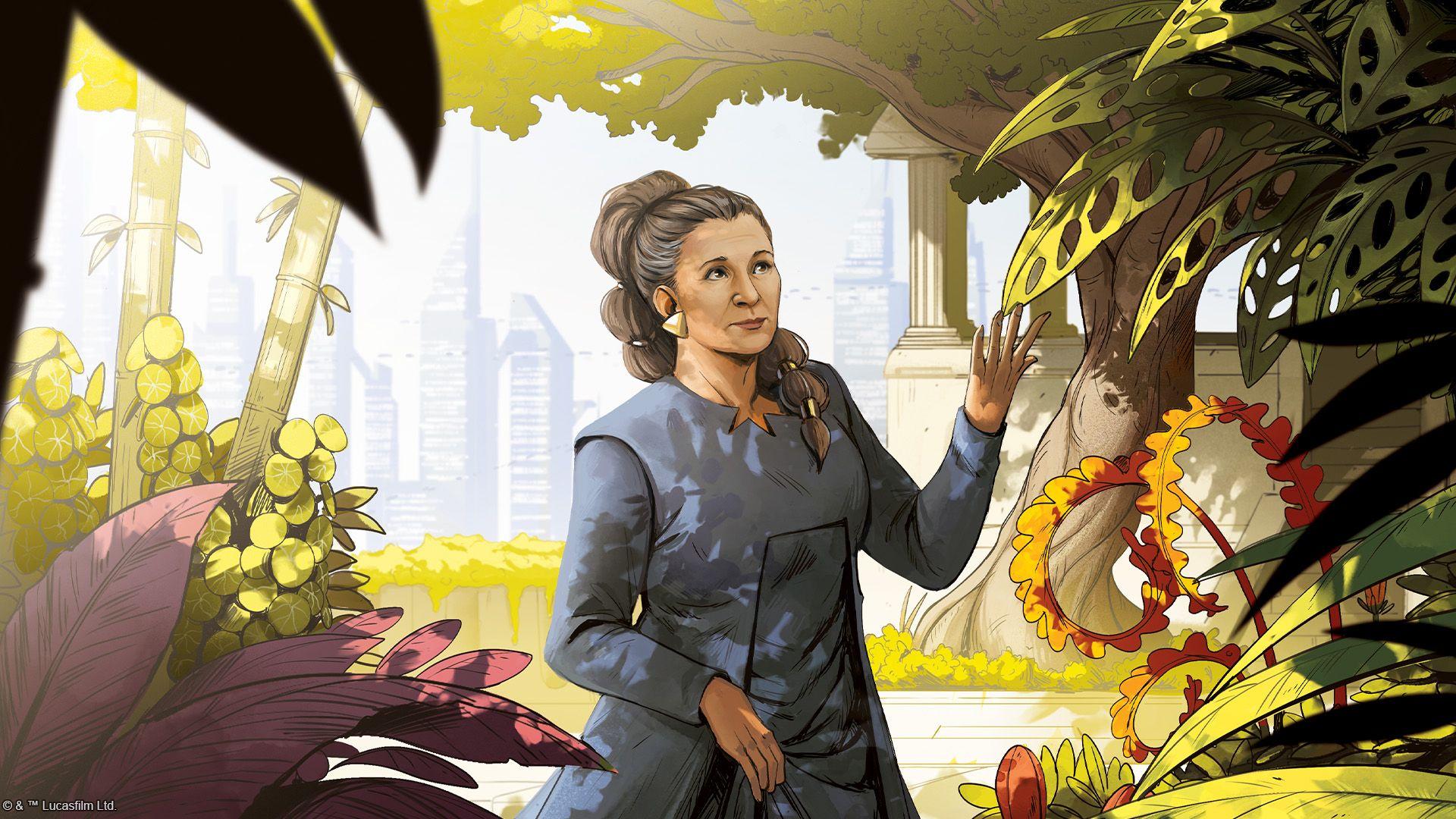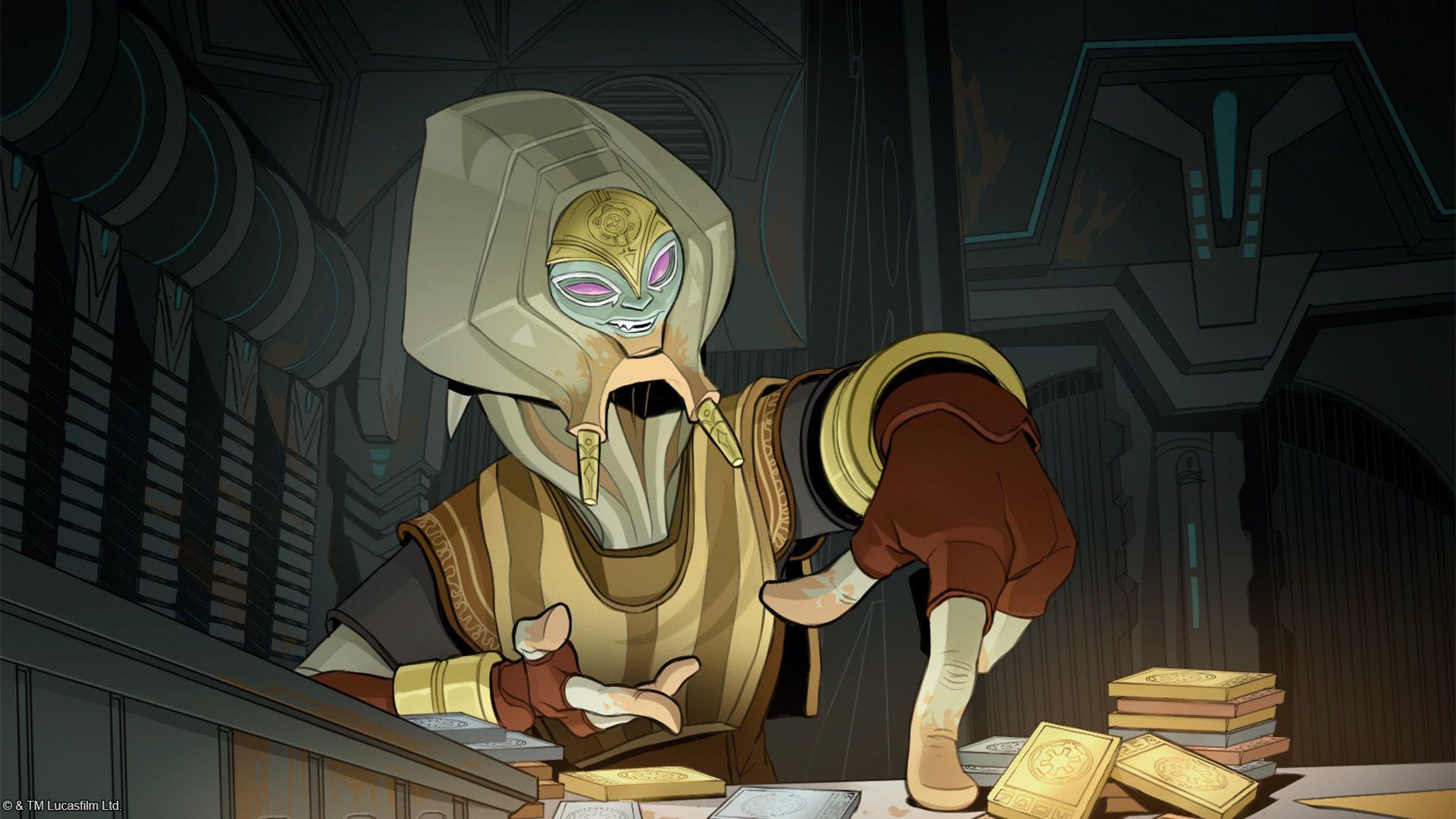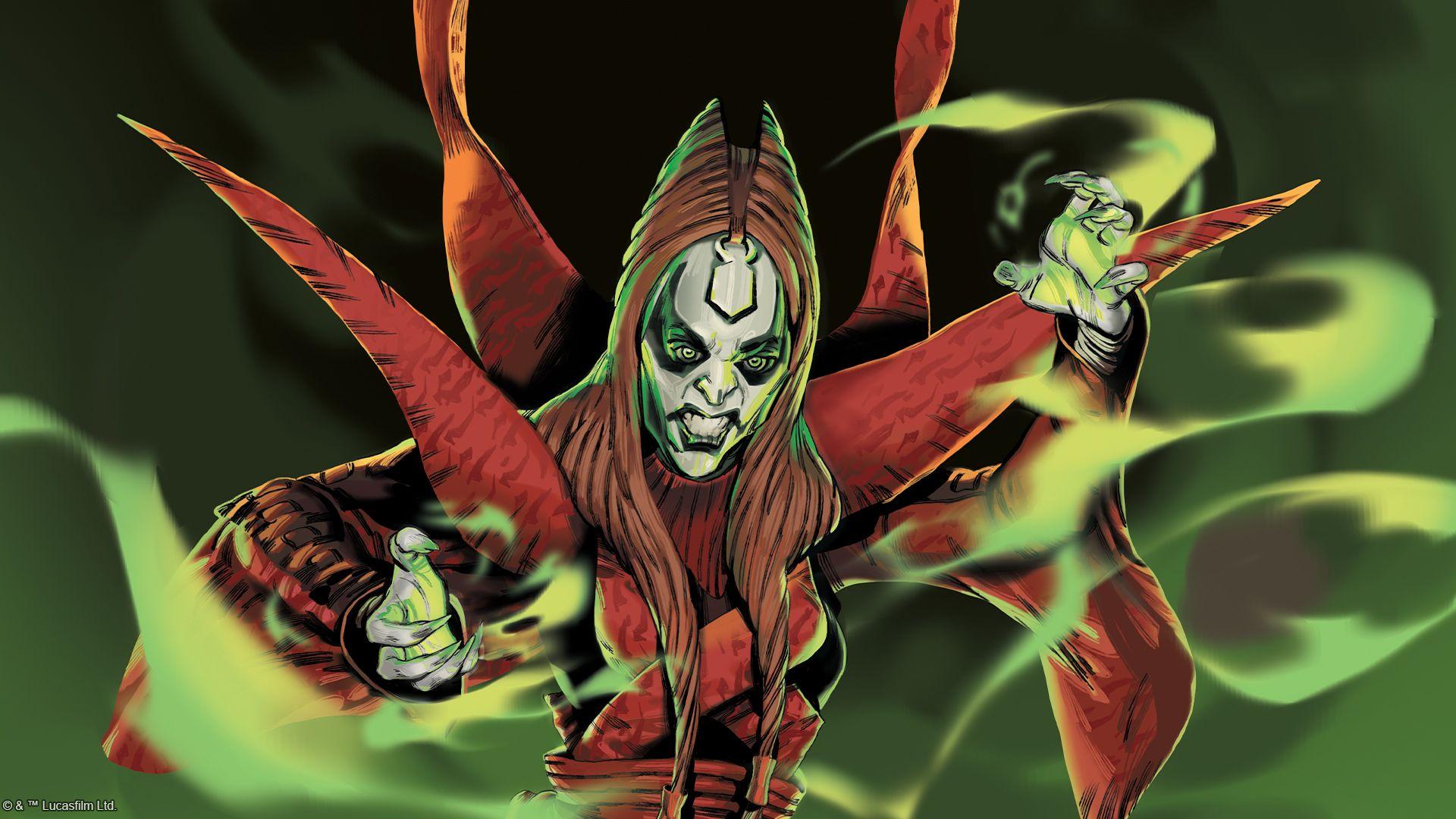Behind Unlimited: Designing “Twilight”

The story of Twilight of the Republic actually starts with the design of Spark of Rebellion, as the first three sets were concepted together. We knew from the beginning that our first set was going to be foundation-building, and that it would be themed around the Galactic Civil War era of the original trilogy. We also knew that our second set needed to not be themed around a time period, to establish that not every set would be based on an “era” of Star Wars™. But some of the most popular elements of Star Wars, to many people, come from the Clone Wars era. Therefore, it was clear that the only way to hit the entire breadth of what we wanted to include in the first year was for the third set of the year to be themed around the Clone Wars.
Expendable Soldiers
The mechanic that would ultimately define Twilight of the Republic started out in Spark of Rebellion. Since Spark of Rebellion’s design set the foundation for the entire game line, we experimented with lots of mechanics, many of which didn’t make it into the final version of the set. One of those mechanics was, of course, unit tokens. We were already experimenting with upgrade tokens, and unit tokens is a design space that’s proven to be extremely popular in other games. Some of the earliest cards we designed made token units based on one of Star Wars’s most famous icons:

Despite some strong passion among the design team, Stormtrooper tokens ended up getting lost among all the core game mechanics that we were trying to introduce in the first set. It quickly became apparent that a whole set could be built around token units, but doing so in the first set would undermine our ability to establish the game’s foundational play pattern. Fortunately, we already knew we had a set coming up that was conceptually built on a war between mass-produced soldiers, so in the same breath that tokens were cut from Spark of Rebellion, they were added to Twilight of the Republic. This became the defining mechanic of the set: 1/1 villainous Battle Droids against 2/2 heroic Clone Troopers.
From there, we explored other themes that would feel natural to a set about the Clone Wars. Some were obvious: the set would support Separatist and Republic trait-based strategies, and each of the two sides of the war would receive their own mechanic related to their respective unit tokens. We also explored possible mechanics-first ideas related to unit tokens. For example, if events that made tokens functioned basically like units, what if there was an alternate way to play units that made them function basically like events? Despite some promising design ideas (left intentionally vague because a good idea is always valuable to have for a future set), we found that anything beyond “Republic vs Separatist” and “unit tokens” as our primary theme was pulling focus and diluting the identity of the set. So we focused our attention on how to bring the conflict between the Confederacy of Independent Systems and the Galactic Republic to life.

Droids Versus Clones
The first question we asked ourselves was: how do the two factions of the Clone Wars treat their mass-produced armies? Where the Separatists engaged with the war through economics and volume, with an overwhelming number of expendable droids, the Republic focused on quality over quantity, and their successes were often brought about by the coordination between their soldiers. Therefore, we put our minds toward play patterns that encouraged sacrificing battle droids and protecting clones.
Exploit came about easily. If we were going to ask players to defeat their own units for value, we needed that value to be strong. One of the strongest things you can do is play a card ahead of schedule, so we made it a cost reduction mechanic. The first version of Exploit that we discussed was simply “sacrifice a unit to reduce the cost by 1,” but it wasn’t very exciting and people weren’t willing to take on that much risk for such a minor reward. As an experiment, we doubled the discount, expecting it would result in cards that were too strong, but found to our surprise that if we overcosted the units a bit (our heuristic was “about 2 resource surcharge” for the flexibility of when and how you play it) it actually played great! The cards were swingy, of course, but it was really exciting when they went off, and players really enjoyed the tension of when and where to Exploit their units.
Coordinate was a bit more difficult, not because it was complex (it’s extremely simple) but because it’s so unexciting to read. Providing a reward for controlling three units isn’t particularly flashy, and there were concerns about how punishing it could be when you fall behind. However, simplicity is one of the core pillars of this game’s design, and there were few other teamwork mechanics that were quite so straightforward. What ultimately cemented the case for Coordinate was how well it played in practice, especially in draft. We were seeing players deviate from the core strategy of “attack the base if you can win the race, otherwise attack units” by encouraging players to attack enemy units they otherwise might not, and to protect units they might otherwise be willing to sacrifice.

Developing the set was difficult because we were still learning about some of the core elements of the game’s gameplay and resource exchanges as we were actively turbocharging them. The advantages we had learned from the development of Spark of Rebellion didn’t carry over into Twilight of the Republic because unit tokens represented a kind of card advantage that had never existed before, while simultaneously allowing for a style of ramp/combo deck unlike anything that existed in the first two sets. We were constantly bouncing between powerful Coordinate payoffs that felt extremely strong in Premier and truly backbreaking in draft, and weaker Coordinate payoffs that felt fun and fair in draft but were underwhelming in Premier. Additionally, the fact that unit tokens simultaneously fueled Exploit, enabled Coordinate, and actively punished the best control strategies from the first two sets made it apparent that there was some invisible advantage to having multiple units that we hadn’t anticipated.
These invisible advantages that we were working to understand informed our development decisions, as did our draft playtests which were proving to be extremely fun. We developed Coordinate under the expectation that a deck dedicated to achieving it would be able to keep it on, but that it would come at a mild deckbuilding cost. We added a limit to Exploit to rein in the most egregious starts (there used to be no numerals on Exploit, and you could sacrifice as many friendly units as you wanted to discount the card you were playing). We made sure there were plenty of ways to keep units on the board, even through multiple rounds of interaction, so that players could be equipped to maintain a board presence against an equipped opponent, and we made sure to include several cards that produced multiple bodies to help decks bounce back if they fell behind. This was the most synergy-driven set we made in the first year, and so we focused our efforts on maintaining the fun of those synergy mechanics without making them oppressive. In the end, we learned a lot from the development process of Twilight of the Republic, and the result is one of my favorite draft environments we’ve made so far.

Leading the Clone Wars
With so much of the set’s core mechanics being locked in early and staying mostly stable throughout development, we were able to really lean into the designs of the individual leaders. As with any set, the common leaders in Twilight of the Republic are designed primarily for draft while the rare leaders are designed primarily for Premier. Each was envisioned to lead a specific kind of deck or play style, and some of them were especially novel and unusual as we wanted to start exploring new design space.

The first leader we put into the card file was actually Palpatine and Sidious. The idea came up while we were figuring out the core mechanics for leaders in Spark of Rebellion, and once someone said “heroic Palpatine who flips into villainous Sidious” we were all sold. We knew he would be in Twilight of the Republic even before we knew what he would do.
Separately, in the same early stage of leader design, we explored the idea of a leader who doesn’t deploy. At that time it was for a different character (you’ll see that character eventually, although with different mechanics), but as with much of Spark of Rebellion’s design we quickly decided it was a fruitful mechanical evolution to save for later. Therefore, when we came around to designing Twilight of the Republic, we realized that Palpatine/Sidious was the perfect leader to explore this non-deploying leader mechanic, as both of his personas are about staying in the background and manipulating from afar. It conveniently solved the problem we had observed whereby having a different aspect icon on a leader unit meant your opponent had a lot of control over when you would be able to play your villainous cards, since the leader unit would quickly get attacked off the table.
From there it was simply a matter of developing the two sides of Palpatine and Sidious so that they were powerful enough to warrant giving up a leader unit but not so powerful that they invalidated the core game loop. The trick was to make sure the engine felt like you got enough value to be worth activating, but to diversify that value enough so that Palpatine/Sidious can’t accrue an overwhelming advantage of a single resource. We also wanted to make sure the two sides felt appropriately mirrored and thematic, and so we created a ludonarrative of “Sidious creates a Clone Trooper so that Palpatine has fodder to cry ‘emergency’ over, and Palpatine draws secret cards so that Sidious has a hand full of villains to spring on his opponent.” The base healing and damaging was added later on to ensure that such a grindy engine could keep itself going while also pushing the game towards an end state.

Another set of leaders that were clear initial designs were Nute Gunray and Captain Rex. With a set introducing unit tokens, it was clear that we’d want a leader that made each kind of token. One of my priorities when designing them was to not let them become a directly mirrored pair, since their output (make a unit token) was already going to play similarly. Therefore I explored ways to make them lean more into their faction’s themes without directly calling out Exploit and Coordinate (which each would have their own leader, as you’ll see).
Nute therefore became the “put Exploit cards in your deck” leader, and his token generation was tied to having multiple units be defeated—the thing that Exploit often does. And since Battle Droids are smaller and more plentiful, his unit was allowed to make a token every time he attacks to keep those engines running. In contrast, Captain Rex’s condition became “attack with a unit”—something that happens naturally, but which does require you to sustain a board presence. Additionally, with his lower deploy cost and with Clone Troopers being noticeably bigger and less plentiful than Battle Droids, his unit only creates one token right away rather than every round. The Trooper-restricted HP buff started life as a Clone Trooper-only buff, but we quickly found that making it affect all your Trooper units would both make Rex feel more powerful and flavorful and also open up his deckbuilding space a lot by pushing you towards (but not requiring) a deck full of Trooper units.

While Nute and Rex were designed to be the token-makers, Padmé Amidala and Count Dooku were quickly identified to be the Republic- and Separatist-matters leaders for the set. One thing that I was extremely trepidatious about was having our faction support leaders be in Command again. We had done it effectively in Spark of Rebellion with Leia Organa and Grand Moff Tarkin, and we were able to branch out of green in Shadows of the Galaxy with Bo-Katan Kryze and Cad Bane, but Twilight of the Republic’s infrastructure required our faction leaders to be green again in this set. It’s a natural home for trait-supporting leaders (it is called “Command,” after all, and is the aspect all about units), but when all of your factions are built out of the same aspect, and that aspect has a defined set of mechanics it can use, it’s very easy for all those factions to start to feel the same. Fortunately for my anxieties, the use of Coordinate and Exploit helped differentiate Padmé and Dooku from Leia and Tarkin quite a bit.
However, Dooku and Padmé started very differently from where they ended up. The first draft of these two leaders were leaning much harder in the direction you’d expect from a 5-deploy “have units on the board” and a 7-deploy “spend cards to ramp faster” design. Padmé’s first ability was that she allowed Republic units to exhaust to help play other Republic units, and Dooku would draw the top card of your deck if it was a Separatist. But these initial designs kept running into development problems: despite multiple nerfs, Padmé kept being too strong, and no matter what we did Dooku just couldn’t survive until he deployed on 7 resources.
Enter: Hunter (Outcast Sergeant). We developed Hunter under the heuristic that each of his individual parts were good, and since he was fundamentally a card advantage engine we were unwilling to take a risk pushing him too hard (too-easy access to card draw is the #1 way a game gets broken). But we had seen similar issues with Hunter during Shadows of the Galaxy development as we were now seeing with Dooku. It was at this point that we deduced that the problem these two leaders kept encountering was that they were too focused on being “in their lane,” so to speak. Both were ramp-focused leaders with card draw abilities on their front side, and with such late deploys it meant that they were incapable of affecting the board early enough to participate in much of the game. Dooku, therefore, needed to get on the board faster so that he could grind his way through the early game until his 7-resource deploy.
Meanwhile, Padmé made getting on board trivial since she was so effective at ramping Republic units into play. But as a 5-deploy leader, she didn’t need the acceleration as much and would be much better off with a card advantage engine to help her sustain into the late game after her early game had brawled. So the answer became clear: switch what these two leaders were doing at a strategic level, and then your late-game leader could have an early-game ability, while your early-game leader could have a late-game ability. We tied them to the keywords like I wanted and lo and behold, both started working just the way we wanted them to.

Another goal we had for Twilight of the Republic was to expand what archetypes were available to hero and villain decks. Because of the theme of Spark of Rebellion, we intentionally seeded the villains with control/removal options and late game powerhouses to match the theme of the Galactic Empire, a faction defined by oppression and giant war machines. In contrast, the heroes were seeded with aggressive/disruptive tools to match the theme of the Rebel Alliance, a faction defined by plucky underdogs trying to steal victory from the jaws of defeat. But after two sets, those decks were doing great. The nature of the Clone Wars, on the other hand, was fundamentally different: this time, it was the Galactic Republic and the Jedi who were the entrenched power in the galaxy, and the Separatists who were trying to disrupt the status quo with an unexpected offensive.
So we intentionally designed a leader for each side that pushed hard in a new direction. Mace Windu became the poster child for the heroic control deck (modeled after Darth Vader (Dark Lord of the Sith)’s playstyle) with his ability to finish off damaged units and deploy in the late game with huge stats. Meanwhile, Wat Tambor became the poster child for the villainous aggro deck, since his stat buff is very large and very free (despite his mechanically on-theme condition). Wat proved that a good villainous aggro deck was possible since removing his units only made the other units hit back harder, and it gave a new dimension to the Battle Droid tokens that made him very distinct from someone like Nute Gunray, who is constantly sacrificing them to card abilities. Both were made rare, since their target audience was Premier players, but as you can imagine they play pretty well in draft as well.

Not all of our leaders were aimed at this set’s themes, however. Once we covered all of the clearly-defined ground, we wanted to see what other cross-set themes we could support in this expansion. One of the things I’d been wanting to do for a while was to follow up on a couple cards and mechanics from Spark of Rebellion. We had intentionally seeded a small “events matter” subtheme into the yellow-villain draft package in Spark of Rebellion, but that deck didn’t have a leader that called that theme out and pulled it together. With Twilight of the Republic full of events that created units, it was now possible to have a higher percentage of event cards in your deck than before, so this was my opportunity to make that leader happen. This led to Asajj Ventress, a leader who rewards you for playing events and provides some fun glue to bring together the yellow cards from Spark of Rebellion and Twilight of the Republic (and future sets!) into a single strategy.
Yoda, meanwhile, was addressing my desire to make a leader that would specifically enable the card You’re My Only Hope (but also other “top-of-deck matters” cards from Spark of Rebellion such as C-3PO (Protocol Droid) and For A Cause I Believe In). You’re My Only Hope was a card I wanted to be iconic, and while we landed on an extremely thematic design, it necessitated both for theme and balance that it not be consistent on its own. It really needed a leader who could help set it up. This is where Yoda entered the picture, a leader who could intentionally stack the top of your deck. The first several versions of Yoda were problematically strong, since he let you dig much deeper and at one point even stack your opponent’s deck. But we eventually learned that for a game with this much built-in consistency, we had to be careful how much free card filtering we could give on a leader. The solution we came to was to let him exchange a card in hand with the top or bottom of your deck, so you could put your You’re My Only Hope or C-3PO target on your deck after you’d drawn it, but there’d also be a thematic condition—when a friendly unit disappears, Yoda senses something’s up and goes to investigate, and when an enemy unit disappears it’s because Yoda is removing threats and learning what they’re up to. This gave you some very effective card filtering, but not for free, and it didn’t dig several cards deep into your deck so you were consistently getting exactly the card you wanted in every game.

I hope you’ve enjoyed this retrospective on the design process from Twilight of the Republic! This is the first entry to my monthly Behind Unlimited series, where I talk in long-form about various design (and occasionally creative or development) topics from behind the game’s curtain.
May you feel inspired to try something new!
Written by Tyler Parrott
Share This Post



